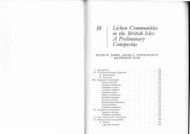You also want an ePaper? Increase the reach of your titles
YUMPU automatically turns print PDFs into web optimized ePapers that Google loves.
habitats, like Parmelia stygia (↑), Char.<br />
Umbilicarion cyl. – arct-bor-h’mo/alp – rare (3);<br />
süSch, Vog, BayW, Erz, Hz; v.rare nöSch, Rhön,<br />
?Ts, ThW, also Al<br />
Cetraria sepincola (Ehrh.) Ach.<br />
In montane to subalpine, mostly high<br />
precipitation sites on temporarily very cold, late<br />
frost endangered, high snowfall, rather variable<br />
humidity habitats on acid bark and wood, in cold<br />
air accumulating basins, in high and moss<br />
overgrown, on peat bogs, below the tree line<br />
almost only on bog-birch (rarely on alder), above<br />
the tree line on dwarf pine with Parmeliopsis<br />
hyp. (↑), r.-v.acidoph., r.-v.photoph., hygroph.,<br />
v.ombroph., anitroph., in the region in the<br />
Parmeliopsidetum and Pseudevernietum – bormieur-mo(-smed-subalp)<br />
– rare (2); Sch, Vog,<br />
Rhön, BayW, Av; v.rare O, Sp, Ju, Hu, Eif,<br />
Sauerl, Erz.<br />
LIT.: ANDERS 1928, HILLMANN 1936, KÄRNEFELT 1979,<br />
1986 KÄRNEFELT & THELL 1993*, KÄRNEFELT ET AL. 1992,<br />
POELT & VÈZDA 1981<br />
Cetrelia W.Culb. & C.Culb.<br />
(Determination ↑ Cetraria)<br />
Introduction<br />
The Cetrelia species are light to bluish gray<br />
foliose lichens with broad, rounded lobes with<br />
black, marginally brown underside and few<br />
attachment threads. Characteristic are fine,<br />
punctiform to short streak-form white<br />
pseudocyphellae on the upper side. The<br />
apothecia are rarely produced; they stand near<br />
the lobe margins and are perforated in the center.<br />
Several species produce border soralia.<br />
The genus (ca. 15 species) is predominantly<br />
distributed over the northern hemisphere,<br />
especially eastern and southeastern Asia. The<br />
three occurring in Germany, are closely related,<br />
but genetically isolated species – they are also<br />
chemical races – occurring in west Europe up<br />
into southern Fennoscandia and in oceanic<br />
regions <strong>of</strong> central Europe especially on<br />
deciduous trees in near natural forests. They are<br />
clearly in regression in the last decade.<br />
Genus Characteristics<br />
Thallus foliose, gray, blue-gray, even browned in<br />
places. Lobes broadly rounded, upper side with<br />
punctiform to elliptical pseudocyphellae, in the<br />
case <strong>of</strong> the indigenous species with border<br />
soralia, underside black, brown at the margin,<br />
with simple rhizines. Cortex ± paraplectenchymatous.<br />
Photobiont Trebouxia. Ap. central- to<br />
marginally located, disk brown to brown-red,<br />
usually perforated, with thalloid margin. Asci <strong>of</strong><br />
the Lecanora type. Sp. 1-celled, ellipsoidal.<br />
Pycnosp. short bacillar, with slight swelling<br />
toward the ends. Ch: Cortex with Atranorin,<br />
medulla with depsides and depsidones.<br />
Ecology and Distribution <strong>of</strong> the Species<br />
Cetrelia cetrarioides (Del. ex Duby) W.Culb. &<br />
C.Culb. (Parmelia c. (Del. ex Duby) Nyl.)<br />
In montane and high montane, rarely even<br />
submontane sites, above all in high precipitation,<br />
relatively oceanic regions, on the bark <strong>of</strong><br />
deciduous trees and spruce, in lower sites like<br />
Parmotrema chinense (↑), in higher sites like<br />
Menegazzia and Lobaria pulm. (↑), m.r.acidoph.,<br />
m.-r.photoph., r.-s.hygroph.,<br />
anitroph., in the Parmelietum revol.,<br />
Thelotremetum with Menegazzia, Lobarion –<br />
s’bor-subatl-med(subatl) – rare (3); Vog, Sch, Al<br />
& SJu r.rare, at times (v.)rare, today strongly in<br />
regression: Ju, Ne, SFW, Bo, Do, Av, PfW, Hu,<br />
We, Eif, O, Sp, Ts, He, ThW, Mn<br />
Cetrelia chicitae W.Culb. & C.Culb.<br />
In submontane, mild sites on the bark <strong>of</strong><br />
deciduous trees in forests, e.g. like Pertusaria<br />
hymenea – atl – v.rare (1); SFW (1x)<br />
Cetrelia olivetorum (Nyl.) W.Culb. & C.Culb.<br />
(Parmelia o. Nyl.)<br />
In montane and submontane sites, probably<br />
bound less to high precipitation and oceanic<br />
regions than C. cetrarioides, e.g. in the<br />
Parmelietum rev., Pertusarietum amarae –<br />
(v.)rare (3); süSch, Ju, Do, Bo, Ne, nöSch, O<br />
LIT.: CULBERSON & CULBERSON 1968<br />
Chaenotheca (Th.Fr.) Th.Fr.<br />
(Key includes Sclerophora)<br />
155





